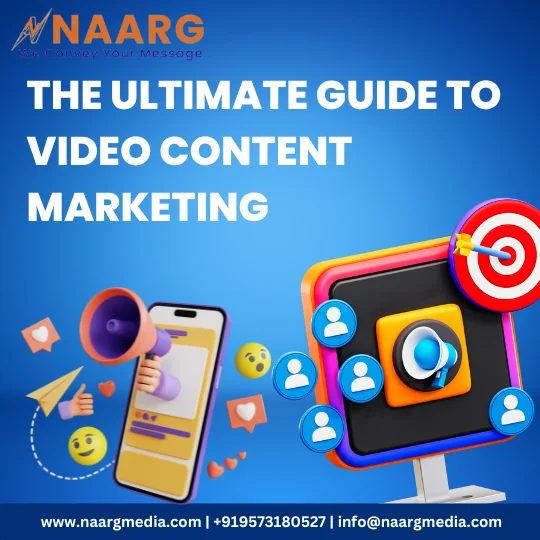If you are reading this blog, it is most likely that you know the importance of video content marketing strategy. Nowadays brands now that they can no longer get by using written content and images only.
Written content and static images are not as engaging for consumers who are inclined towards live streaming, augmented reality, and interactive 360 videos. 92% of marketers now believe that videos will play a crucial role in the marketing genre in the coming years.
This means brands and businesses are realizing the value of video content marketing and are investing in its creation and distribution. You will be left behind if you are not investing video content marketing strategy for your brand.
We know that getting started with anything new can be tough. Now that’s where we come in!
This blog will help you understand the ins and outs of video content marketing strategy, the types of video content, its benefits, and much more. Start reading to learn everything you need to know about video content marketing strategy.

What is Video Content Marketing?
Now before getting deep into video content marketing strategy, first let’s understand what video content marketing is. It is a strategic approach to creating and distributing content that is video-based and that engages, educates, and entertains audiences while driving business objectives.
Brands use video content to promote their products or services or their brand message through different social media platforms like social media, websites, and video-sharing sites like TikTok and Instagram.
Video content marketing is different from traditional advertising; this content marketing focuses on providing value to the audience. Whether it is through visual storytelling, testimonials, or behind-the-scenes looks.
Moreover, the ultimate goals of video content marketing are to build stronger connections with their viewers, enhance brand awareness. And encourage actions that contribute to conversion rates. Once you leverage the power of visual storytelling, it can help you capture attention in an increasingly crowded digital space.
Types of Video Content Video
content comes in many types and formats, and each one of them serves a different purpose in a brand’s marketing strategy. Listed below are some of the effective types of video content that any business can use to engage its audience.
1. Explainer Videos
Explainer videos are informative and short videos and are designed to explain a product or a concept simply and engagingly. These types of videos help clarify complex ideas and can be used to introduce new features or answer frequently asked questions.
2. Product Demos
These types of videos showcase a product’s features and illustrate how it works. Product demo videos highlight the value and benefits of a product or a service. Thus making them an essential tool for increasing conversion rates.
3. Brand Storytelling Videos
Visual storytelling brand videos aim to connect with the audience on an emotional level by sharing the brand’s mission, journey, and values. These brand storytelling videos often highlight the people behind the brand or tell a story about how the business was founded.
This creates a personal connection with the audience and builds brand loyalty.
4. Customer Testimonials
Testimonial videos generally feature satisfied customers sharing their positive experiences with a product or service. These types of videos serve as social proof and build credibility, as the potential customers trust the words of real users.
These videos are especially powerful when used during the consideration stage of the buyer’s journey. Thus helping the audience to overcome objections and boost confidence.
5. User-Generated Content (UGC)
User-generated content is those types of videos that are created by the brand’s customers or fans. And it includes anything from product reviews to social media challenges.
With user-generated content videos, brand scans foster a sense of community and authenticity. As potential customers are more likely to trust content created by their peers.
Benefits of Video Content Marketing
Listed below are some of the key benefits that video content marketing offers.
1. Increased Engagement
As we all know, and many statistical data has also revealed that videos can significantly boost conversion rates. Video content captures attention quickly and holds it longer, all thanks to the dynamic nature of video content.
The viewers are more likely to engage with videos by leaving a like, sharing the video, or commenting, especially on social media platforms. The combination of visual storytelling and sound keeps the viewers invested. Thus increasing the engagement rate and the likelihood of them staying on a page or social media platform for a longer period.
2. Higher Conversion Rates
Engaging videos can significantly boost conversion rates, whether the videos are embedded on a website, or landing page, or used in email marketing. There is much research that shows that landing pages that have videos can increase conversion rates to an increasingly higher number.
Videos like product demos, testimonials, and explainer videos make it easier for potential customers to understand the value of a product or service. Which in turn encourages the viewers to take action, like making a purchase or signing up for a service.
3. Improved SEO Rankings
Google as a search engine favors video content, thus giving video-rich websites higher rankings in search results. Embedding optimized and relevant videos on your site can increase the chances of appearing on the first page of search results.
Additionally, SEO optimization of video is essential as it increases dwell time. Like the amount of time visitors spend on your website, which is another crucial factor that boosts SEO.
Video Content Marketing Strategy Development
Video content marketing strategy development is crucial to ensuring that your efforts are effective, targeted, and measurable. We have listed some steps for video content marketing strategy development.
1. Define Your Goals
One of the foremost requirements for your video content marketing strategy is to have a clear purpose. So, always start by outlining the key objectives of your video marketing efforts. When you have a specific goal in mind, it helps you guide the direction of your video content.
And additionally it also ensures that each of your videos aligns with your overall business.
2. Understand Your Target Audience
Then comes the next strategy, and that is knowing who your audience is and what they care about, as it is crucial to create video content that resonates. You can start by identifying key demographics like age, location, gender, and interests, as well as their pain points and preferences.
This strategy is crucial because the more you understand your audience, the better you can tailor your content to meet their needs.
3. Plan Your Video Content
Once you have decided the purpose of the video and you know the audience demographic, then it is time to plan them in detail. So, start by creating a content calendar that outlines what videos will be produced, when they will be published, and what social media platforms will be shared.
Creating a content calendar is essential as it keeps you aligned with important events, product launches, or industry trends.
4. Optimize Your Videos for SEO
Now the next strategy is to optimize your videos for SEO to reach a broader audience. SEO optimization for videos involves using keywords, tags, descriptions, and titles to make your videos discoverable across different social media platforms.
For SEO-optimized videos, you need to create compelling thumbnails and add clear calls to action within your videos and descriptions to drive engagement and conversions.
Moreover, when you follow these strategies, it can help you develop a comprehensive video content marketing strategy that not only enhances your brand’s online presence but will also drive measurable results.
Elevate your video content creation with our expert translation and localization services.
Contact us today to learn more about our services.

